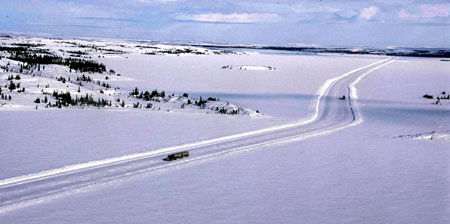| ||||||||||||||||||||||||||||
Proactive disclosure Print version |  Climate Change Impacts and Adaptation: A Canadian Perspective Transportation
Transportation is an essential element of Canadian economic and social well-being. The main components of our transportation system are roads, rail, air and water, all of which play important though varying roles across the country. Assessing the vulnerability of these components to climate change is a key step toward ensuring a safe and efficient transportation system in the future. Climate change is expected to impact transportation primarily through changes in temperature, precipitation, extreme events and water levels (Figure 7). The most vulnerable transportation systems include ice roads, Great Lakes shipping, coastal infrastructure and infrastructure situated on permafrost. Impacts would vary regionally, with both challenges and new opportunities expected. In some cases, benefits would have the potential to outweigh future damages, and a warmer climate may translate into savings for those who build, maintain and use Canada's transportation infrastructure.
In southern regions of the country, an increase in summer temperature would affect the structural integrity of pavement and railway tracks, through increased pavement deterioration and railway buckling. It is expected, however, that losses incurred in southern Canada during the summer would be outweighed by benefits projected for the winter. Damage to pavement from freeze-thaw events would likely decrease in much of southern Canada, and the costs and accidents associated with winter storms are expected to decline. Changes in precipitation patterns could also affect transportation infrastructure. Future increases in the intensity and frequency of heavy rainfall events would have implications for the design of roads, highways, bridges and culverts with respect to stormwater management, especially in urban areas where roads make up a large proportion of the land surface. Accelerated deterioration of transportation infrastructure, such as bridges and parking garages, may occur where precipitation events become more frequent, particularly in areas that experience acid rain. An increase in debris flows, avalanches and floods due to changes in the frequency and intensity of precipitation events could also affect transportation systems.
 Although there would be some advantages associated with higher temperatures associated with higher temperatures (e.g., fewer periods of extreme cold would benefit railways), there would also be several new challenges. Permafrost degradation, and its effects on the structural integrity of roads, rails and runways, is a key concern. The social and economic implications of a shortened ice-road season are also important to consider. Recent warm winters have resulted in the governments of Alberta and Manitoba having to spend millions of dollars flying supplies into communities normally served by ice roads. In coastal regions, changes in water levels would affect transportation infrastructure and shipping efficiencies. Rising sea level on the coasts would increase flooding and storm surges, with potential consequences for causeways, bridges, marine facilities and municipal infrastructure. In the Great Lakes-St. Lawrence Seaway, lower water levels would decrease the efficiency of shipping operations by reducing cargo volumes. Shipping opportunities in northern Canada may increase due to less ice coverage and the potential opening of the Northwest Passage. This would present both new opportunities and challenges for the North, creating new possibilities for economic development, but also raising safety and environmental concerns. The impacts of climate change on transportation over the next century in Canada are expected to be largely manageable. Key adaptation initiatives include incorporating climate change into infrastructure design and maintenance; improving information systems; and increasing the resiliency and sustainability of transportation systems. For example, in northern Canada, future changes in permafrost should be considered in the selection of routes for roads and pipelines.
|